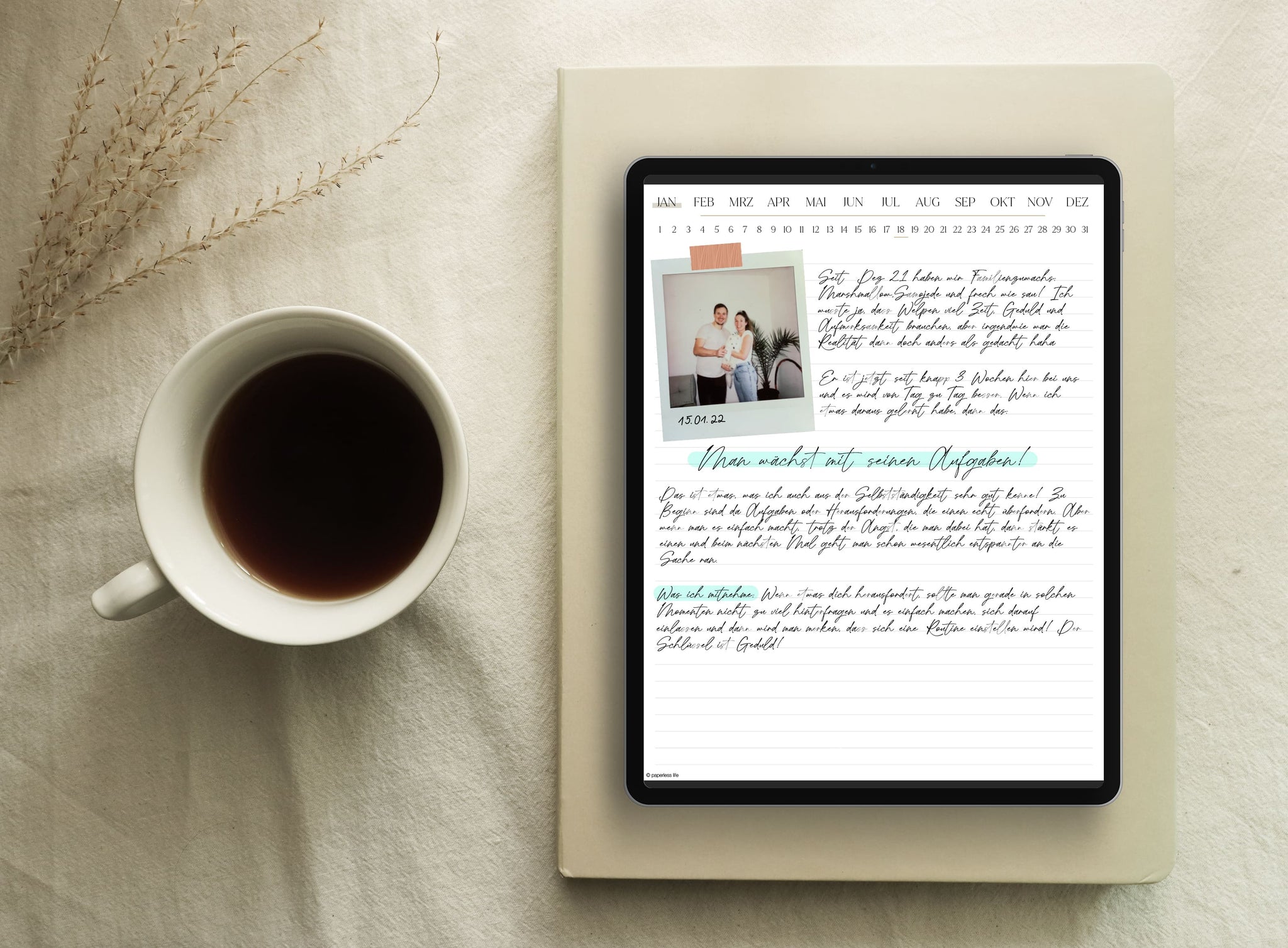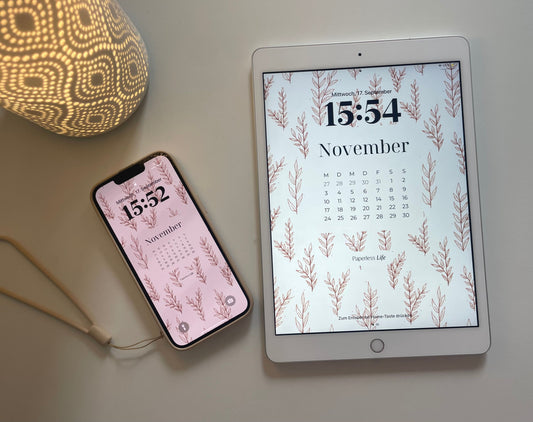Keeping a digital diary, a success journal, or a gratitude journal—writing is back in fashion. We capture our thoughts, experiences, and feelings on a piece of paper and can work with the written words. It's an important tool for self-reflection.
When you release your emotions on paper, you unburden your soul. Your sense of well-being increases and inner pressure subsides. It has long been known that the psychological effects of writing have a positive impact on our well-being. In this article, you'll learn why writing is good and how you can take advantage of this effect with a digital diary.
What effect does writing have?
Writing relieves stress. If we don't engage with our emotions and feelings, these feelings can build up and our inner stress can increase. A negative mood and thought loops follow.
When we experience painful experiences , we can process them much more easily if we express and "release" our emotions. Talking to people can be a great outlet. But what if we can't or don't want to confide in others?
Where this conversation partner is lacking, a diary comes into play. A diary can replace an intimate conversation. By writing, we give our feelings space and can process them. We confront the issues that concern us internally. These can be fears or desires, but also experiences and experiences. A diary doesn't have to be a refuge exclusively for bad times; you can of course also share positive experiences in it, such as successes, learnings, and moments of happiness.
By formulating your thoughts, they surface in a structured way. Writing makes the invisible visible. You can then work with the written words. You can reread them, analyze them, and thereby recognize and break down recurring patterns. A journal is an essential tool for self-reflection.
Writing is a form of self-expression
Because we're writing only for ourselves, we can be as honest as possible. Whereas feelings of shame or embarrassment might stifle our emotional outpouring in dialogue with others, we feel little embarrassment with paper. This allows us to enter into a very honest and direct dialogue with ourselves and process things more quickly.
Furthermore, transforming negative experiences into a historical context can give the whole thing a new meaning. As the director of your own story, looking at things from a distance can give the experiences a new context.
Regular writing helps you better understand and engage with your thoughts and feelings. This process inevitably leads you to get to know yourself better and lays important foundations for self-reflection.
What is a digital diary?
Just like with an analog paper diary, you also take notes in a digital diary – but digitally. This can be done on a laptop, computer, with an app on your smartphone, or with a digital diary on your tablet or iPad.
If you're not familiar with how digital planners work, you'll learn exactly how they work in this blog post . Digital planners are PDF files that use hyperlinks. These planners combine the benefits of digitalization with the analog world of handwriting.
You use digital planners on your tablet/iPad in combination with a stylus. You can also use digital planners on your PC or laptop without a stylus, but then, of course, the handwriting component is eliminated. This is the biggest advantage for me, especially when keeping a digital diary! It allows me to use my diary digitally on my iPad with a note-taking app like GoodNotes and keep it by hand, just like in analog planning.
Why keep a digital diary?
By using the digital diary on your tablet or iPad, you save a lot of paper! Paper planners are usually used only once and then end up in the trash. The digital diary is undated , and you can use it again every year. You have a one-time purchase cost and you save paper.
The digital diary works with hyperlinks. The months January to December are shown at the top of the page view, and the corresponding days of the month are shown below. For example, if you want to access the daily page for February 14th, click on the month February and then on the 14th. This will immediately open the respective day.
You have one page for each day. In a digital planner, however, you can duplicate each page as many times as you like. So, if you need more space for your notes, you can simply copy the page and paste it again. There's no shortage of space in digital planning.
Fill your digital diary with photos, quotes, stickers, and other ideas! Let's say you're sitting at the breakfast table in the morning and want to capture the moment in your diary. You can take a photo with your tablet or iPad and insert it into the diary. You can also insert, move, and crop previously taken photos.
For the ruling, you can choose between lined, squared, dotted, or blank. The diary is also available in white , cream , or with black pages . Digital planners in dark mode look really cool with white handwriting, but that's a matter of taste, of course. Black pages might be easier on the eyes.
Digital stickers that you can use in your journal are creative highlights for planning. Working with them is fun and provides variety. I designed these stickers specifically for journaling – in shades of blue and cream .


What goes into a diary?
The short answer: everything that moves you. A diary isn't just for bad days. Positive experiences, feelings, and thoughts should also be included, because then you'll inevitably reflect on your successes and positive moments in life, and that can give you a boost.
Here's an example of a journal entry. I described the situation with my puppy and what I've learned in the few weeks since I got him. Everything that moves me goes into my journal. These can be positive, but also negative thoughts/experiences. However, I always try to "close" the lines with positive feelings. If something happens that upsets me emotionally, I end the journal entry with a gratitude exercise. Reflecting on what you're grateful for brings the small, positive things that are often overlooked back into focus.

Keeping a digital diary - how does it work?
✏️ What do I need?
To fully utilize the benefits of a digital diary, I recommend using it on your tablet/iPad in combination with a stylus for handwritten notes. You'll also need a note-taking app for your operating system. There are free and paid note-taking apps; you can learn more about them in this blog post . Since I'm an iOS user, I chose GoodNotes. Great app and super intuitive!
✏️ How often?
I recommend that you write in your journal regularly so that you can really feel the positive effects of writing and use it for self-reflection. By regularly, I mean every day, ideally at a specific time . There will always be days when you don't have much time - that's okay. It's not about you having to write a novel every day, it's really about consistency! Make it a habit to write regularly. It is particularly helpful if you set a fixed time for it and if your journal is in a specific place, provided you don't need your tablet or iPad for other purposes during the day. Once it has become a regular routine, you will find that it will be much easier for you to write in your journal every day.
Possible locations & times are:
- Immediately after getting up in the morning
- With morning coffee
- At breakfast
- On the way to work/university/school
- During the lunch break
- Right before going to bed
✏️ What would you like to write about?
What do you want to write about? What moves you? There are various purposes for which you can use a journal. Personal journal, travel journal, gratitude journal, success journal, therapeutic journal, to name just a few.
Write about everyday thoughts and experiences, or practice gratitude daily to take that positive energy with you. Success journals are great for building more self-confidence and self-esteem, making you aware of your successes. People with low self-confidence, in particular, tend to downplay their own achievements. Or maybe you travel a lot. Travel diaries are valuable because memories of experiences fade, while diaries don't.
Most of my diaries are from my backpacking trips, when I was on the road a lot. I wrote down everything that moved me on my journey: experiences, thoughts, quotes, photos. They're incredibly wonderful keepsakes!
✏️ Overcome writer's block
It's always possible that you'll get stuck while writing. That's perfectly fine and can also be related to inner beliefs. What might be normal for younger people can be challenging for an adult. It's important not to put yourself under pressure. Only sit down with your tablet and pen when you feel relaxed and ready for introspection. This could be in the morning after you wake up, in the evening before going to bed, or somewhere else, such as in nature.
Formulate a story with words. If you find it difficult to write coherent sentences at first, try using individual words in a mind map. They can gradually be brought together to form a bigger picture. Don't overthink what form you need to put your thoughts into; just write for the sake of writing.
✏️ Formulate questions
Perhaps questions will help you stay in the flow of writing! Then you can start each day with a question: How am I feeling today? What am I grateful for? What am I hoping to achieve today? What did I learn yesterday?
Questions like these can provide a common thread and make journaling easier. You can also write in your journal twice and create a fixed structure. In the morning, you can think of three things you're grateful for and start the day with positive energy. In the evening, you can use the time for a brief reflection on the day and ask yourself what went well and what didn't go so well.
✏️ Recognize yourself
Writing promotes self-reflection and, in the long run, leads to a better understanding of yourself. Keeping a digital journal could become an important part of your self-reflection. As you engage more and more with yourself, you get to know yourself, your strengths, and your weaknesses. This inevitably leads to greater balance, self-confidence, and resilience.
Further information:
https://www.apotheken-umschau.de




